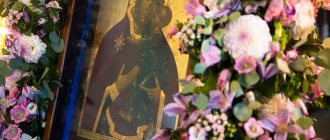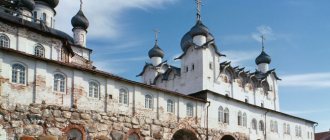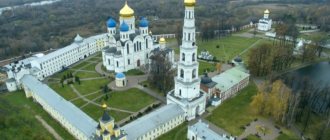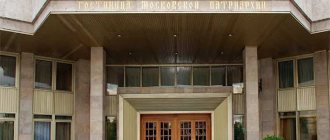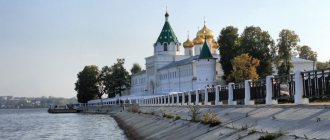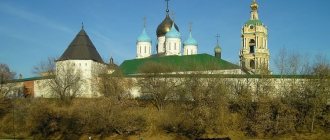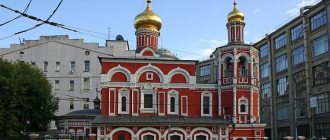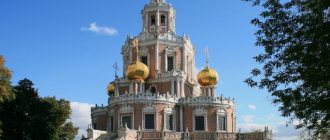What's the best way to get there?
How to get to the Pskov-Pechersky Monastery from Moscow:
- take the daily train to Pskov;
- then either by taxi or by bus from the Pskov bus station via Pechki or Stary Izborsk to Pechory.
How to get to the Pskov-Pechersky Monastery from Pskov:
- your car;
- by bus No. 207 through Old Izborsk (flights daily, from 7:30 to 20:10);
- by bus from the bus station through Pechki (flights daily, from 8:30 to 22:00).
Visit. Operating mode
The territory of the Holy Dormition Pskov-Pechersky Monastery is limited to guest visits only a few days a year: this applies to caves (January 6–9 and August 26–29). Of course, it’s worth planning a visit to the monastery in advance. Otherwise, you won’t be able to see the caves of the Pskov-Pechersky Monastery or enter the temple: it’s better to tailor your visit to the services being held and the days of the week. This means that on Monday and Friday no one will be allowed into the Far Caves, and the Near Caves begin cleaning about an hour before the start of services in the monastery.
- excursions from 9 a.m. to 4 p.m.; someone conducts them every hour (either local bureaus or the monks themselves). The payment is donations. You need to sign up for excursions either by phone (up to 5 people) or by filling out an application form on the website (pilgrims).
- The appearance must be appropriate for the establishment: no uncovered parts of the body; for women, a covered head and a long skirt are required (take your own, in case those offered at the entrance are not enough for everyone).
- It is better to clarify what exactly you can photograph when entering the monastery.
- In addition to the excursion program and worship, you can get water from the Kornilievsky consecrated well .
- When the liturgy lasts, you can go to confession and communion in church .
- the Sretensky Church readily answers questions from guests from 10:00 to 18:00 .
“A formidable governor, a humble man”: about the life and ministry of Archbishop Gabriel (Steblyuchenko)
Archbishop of Blagoveshchensk and Tyndinsky Gabriel (Steblyuchenko) on the streets of Jerusalem May 20 marks the 5th anniversary of the repose of Archbishop of Blagoveshchensky and Tyndinsky Gabriel (Steblyuchenko). The image of Vladyka Gabriel, this “Terrible Governor” of the Pskov-Pechersk Monastery, became known thanks to the book of Metropolitan Tikhon (Shevkunov) “Unholy Saints”. Today, Archbishop Gabriel is remembered by nun Olga (Kaurova), who spent 21 years as a cell attendant and regent of the bishop’s choir under the blessed hierarch.
– Mother, how did you meet Vladyka Gabriel?
– I was born in Khabarovsk. In the cathedral of this city, our mother, Lilia Serafimovna, was the regent. There were 4 girls in our family (Maria, Anyuta, me and Lyusya), and my mother raised us alone, since my father died early.
In 1988, shortly before the feast of the Dormition of the Blessed Virgin Mary, it became known that a new bishop had been appointed to the diocese, who came from the distant Pskov-Pechersky Monastery. Of course, we all got ready to go to the first service, which will be led by the new bishop. Usually the weather in the Far East is very hot at this time, but I managed to catch a cold and, being at home with a fever, was unable to go to work. In the evening, the family returned from the service, and I asked my older sister: “Anyuta, how is the new bishop?” She answered: “An ordinary bishop: big, in a burgundy cassock and with a large panagia.” And I immediately imagined the image of a kind and strong-spirited ruler, whom I wanted to get to know as soon as possible.
“An ordinary bishop: big, in a burgundy cassock and with a large panagia”
I soon recovered and finally went to work. In our church, Bishop Gabriel established a tradition of singing his favorite Akathist to the Sweetest Jesus instead of kathisma at the Sunday all-night vigil. When the clergy came out to the middle of the temple, the choir singers also went down to sing, and I came closer to one of the priests in order to better hear the words of the Akathist. At this time, the bishop read his song, and then called the priest standing to his right and said something in his ear. He began to look around the church for someone, and then pointed at me: “Here you are, come to the bishop!”
I was short in stature and, approaching the pulpit, I saw the bishop nearby, who seemed very large and majestic to me. He looked at me appraisingly and began to take something out of his pocket, then leaned over to me, gave me 10 rubles and said: “Go buy some candles and light them” (indeed, there were very few candles on the candlesticks). I bought 10 large candles for a ruble and placed them throughout the temple. The following Saturday, at the all-night vigil, the bishop called me again and gave me 25 rubles - I put more candles. A week later he gave me 50 rubles, then 100 rubles. I enjoyed buying and lighting candles so much, performing this as a small obedience from the bishop, that every Saturday I literally flew to the service.
And one day the impossible happened! When I was standing not far from the pulpit during the all-night vigil, Bishop Gabriel suddenly called me and told me to bring his rod, which stood on the pulpit, near the royal doors! I calmly went, took this heavy “stick” that was as tall as me and brought it to him. So I became his constant “staff bearer” at every Akathist. With the staff in my hands, I went to the store to buy those ten-ruble candles.
Archbishop Gabriel (Steblyuchenko)
– Tell us more about memorable stories from life in Khabarovsk.
– About a year after the bishop’s appearance, on one of the Sundays in June, towards the end of the liturgy, I saw an incomprehensible bustle: people standing in the church with flowers in their hands began to move towards the pulpit. Among them were representatives of the city administration with bouquets, gifts and souvenirs. To my question “What’s going on?” Mom answered me that today is the birthday of Bishop Gabriel. Then I asked: “Mom, what will we give him?” - “Daughter, should we also give something, since we don’t know him closely?” - Mom answered. She had only one ruble left, and I asked her permission to spend her last funds on buying flowers for the Bishop. Mom paused and said: “Okay, take it, of course.”
I asked permission to spend my last funds on buying flowers for the bishop
I ran to the market to buy roses. It later turned out that these were his favorite flowers. I was very afraid that I wouldn’t have enough money to buy these expensive flowers. Approaching the flower girl, I asked for one rose, and she answered me: “Girl, we don’t sell one rose at a time, only in bouquets.” “How many roses are there in one bouquet, and how much will it cost?” – I asked. The flower girl replied that she was selling three roses in a bouquet, and it cost exactly one ruble - exactly the amount I had. The saleswoman chose the most beautiful flowers, and I rushed to the church, where they were already congratulating Vladyka with might and main and giving him gifts (by the way, Metropolitan Tikhon is now serving with the staff that was presented to Vladyka Gabriel on that very day).
I decided to wait for the bishop outside, at the entrance. Some curious women were sitting on benches nearby, saying to each other: “Oh, look, look, she’s going to give him flowers now!” Now he’ll drive her away!” “Let him not drive you away!” - answered the other one. “No, he’ll drive you away!” - the first one insisted. “Well, let’s see,” the second one resigned herself. My older sister Masha even took her glasses out of her purse to better see what was happening.
Archbishop Gabriel left the church, I went up to him and handed him flowers: “Vladyka, bless! I congratulate you!" “What are you congratulating me on?” – he asked condescendingly. "Happy birthday!" – I answered. "Save me, God!" - the bishop answered majestically and went to his room, accepting my modest gift.
Archbishop Gabriel (Steblyuchenko), Abbess Georgiy (Shchukina), nun Olga (Kaurova) and Nikolai Derzhavin at the opening of the monument to the Prophet David in the Holy Land. 2008 – Was there a continuation of this story?
- Yes. That same day, in the evening, before the service, the deacon approached my mother and said: “The Bishop invites you and your daughter, but I don’t know which one, to come to him.” “I know what kind of daughter,” the mother answered with a smile. We came with her to the bishop's house. It was very beautiful, clean, cozy, and there was a slight pleasant smell of rose oil. The bishop had a very clean office with beautiful, neat curtains. A lamp was burning on a table covered with green cloth. Vladyka invited us to sit down, and then said: “You congratulated me today, and I would like to thank you.” He gave me a Bible for children, signed in his hand, and a small icon.
Then I remembered my mother’s words that the first icon given by the priest was special, and I eagerly took it out of the box. It was a triptych - icons of the Holy Trinity, Prince Vladimir and Princess Olga. This gift turned out to be, one might say, prophetic: I subsequently entered the Regency School at the Moscow Academy of Arts and Sciences in the Trinity-Sergius Lavra, and in monasticism, Bishop Gabriel named me Olga, in honor of our holy princess.
– Did communication with the bishop somehow contribute to your intention to become a nun?
“With the arrival of Bishop Gabriel in our diocese, a large number of new books appeared in the bookstores and library that were not there before, the services became more solemn, I myself felt joy, and my faith and desire to serve in the Church became stronger and stronger.
My faith and desire to serve in the Church became stronger and stronger
One day, when my sisters and I were at home, my mother said: “Girls, I want one of you to become a nun. This was once my dream, but may it come true in one of you.” The eldest, Maria, refused immediately. And I said to myself: “A monastery? Nun?! Not me!" – and quietly stood up and began to walk away from the living room along the wall.
But one day, while at a church service, when I was not singing due to a slight cold, I felt someone’s inviting gaze. I looked at my mother - it wasn’t her, at the choir - and no one was calling me from there, and then I looked at the icon of the Savior and realized that it was His call. From the eyes of Christ, I realized that He wanted me to become a nun. Then I internally agreed with the call and made a promise to the Living God to accept monasticism. At that moment I was 15 years old.
“I know that your entire family has become close to the bishop. How did this happen?
Archbishop Gabriel (Steblyuchenko) - In January 1991, I learned from my mother the sad news that Bishop Gabriel had been removed from ministry. She said that they were collecting signatures against the bishop in the church, and that a priest should come to our house so that we could sign something there. That day we just went for a walk, not wanting to communicate with anyone about this unpleasant topic for us, and thus did not sign anything...
Mom came to the bishop’s house during these difficult times for him, helped him prepare food, and then, at the request of the bishop himself, taught him to cook on his own, and he did everything himself.
In July 1991, my mother called Bishop Gabriel and said that I was going to enter the regency school of the Moscow Theological Academy, and she would go to the airport to see me off. Then Vladyka also came to the airport by trolleybus to see me off and wish me all the best. He blessed me and we said goodbye. And I, looking at the bishop with a sad look, made a promise to myself that I would definitely find him and visit him, no matter how my fate turned out.
I entered the regency school immediately, and I am sure - thanks to the blessing and parting words of our bishop. I really enjoyed studying. Everything in the Lavra was conducive to prayer and work.
Vladyka Gabriel lived in Khabarovsk all this time. Later, after being reinstated in ministry at the Blagoveshchensk pulpit, he told me about the difficult days of his loneliness: he had no money, there was nothing to live on, he could not get a job. And then he remembered one episode that happened when he was the abbot of the Pskov-Pechersky Monastery - gold coins.
– The story with the gold coins?
- Yes. One day he was summoned by the ruling bishop, Metropolitan John (Razumov). Father Gabriel (then still an archimandrite) came to the metropolitan, they had lunch, and Vladyka John took out of the room a very heavy bag, which, as it turned out, contained gold royal coins. Archimandrite John (Krestyankin) had previously given them to Vladyka John. Metropolitan John, apparently, foresaw the future trials of Bishop Gabriel and handed over the bag of gold to him. In fact, this gift saved the life of Bishop Gabriel during the hungry, cash-strapped years of his ban...
Metropolitan John (Razumov) and Archimandrite Gabriel (Steblyuchenko)
– Who came to Vladyka and helped him during this difficult time?
- Almost no one. Everyone turned away from Vladyka, no one wanted to communicate with him, and only Father Tikhon (Shevkunov) continued to call Vladyka Gabriel and help him as much as possible. My mother and sister also visited Vladyka and helped with the housework. It is sad that the bishop was not allowed to take even his personal belongings from the diocesan administration. At this time, Vladyka read a lot, studied English, and developed himself.
Then many abandoned the disgraced archpastor, stopped calling and communicating... Vladyka Gabriel remembered those years very hard... It was especially bitter for him to remember the completely wild accusations against him and the behavior of his flock. Vladyka said that before going to Moscow for the Synod meeting, where the accusations were voiced, he asked the accountant to buy an air ticket to Moscow. The woman accountant, bursting into tears, told me what a terrible picture she had just seen in the cathedral, where someone had placed a piece of paper on the bishop’s pulpit with the inscription: “Gabriel is the non-bishop of Khabarovsk.” Vladyka immediately came to the temple and asked the abbot how to understand all this. He identified himself as the author of the note and stated that the bishop was no longer his bishop.
The diocese was in chaos. Everything literally collapsed before the eyes of Bishop Gabriel... Arriving in Moscow, he heard accusations and was banned from serving as a bishop. The saddest thing is that during the entire time the Bishop served in Khabarovsk, someone regularly wrote denunciations against him... And this despite the fact that in many modern Far Eastern cathedral cities it was through the efforts of the Bishop that the first parishes were opened! At that time, my mother was also fired from her position as regent...
Archimandrite Gabriel at a service in the Pskov-Pechersk Monastery
Archimandrite Gabriel (Steblyuchenko), Archimandrite John (Krestyankin) on the feast of the Dormition of the Mother of God, Pskov-Pechersky Monastery
– Yes, with all the severity of Bishop Gabriel, it is difficult to imagine him as evil and ignorant, which is what these accusations were based on...
– Vladyka was a well-mannered, polite and neat person; he never allowed himself any liberties or licentiousness. He was very decent. Of course, he did not tell me about all the difficulties of that time, pitying me and not wanting to upset me, but he said that it was difficult to convey in words the accusations and horror that he experienced. The Bishop could not believe that he could not serve for 3 whole years, i.e. perform the main work of a priest and monk. On the way back on the plane, the already banned bishop slept soundly. It was very difficult. The Bishop did not accept the accusations brought against him, but he could not do anything other than reconcile himself.
Then, by the grace of God, the bishop was restored to his episcopal dignity and appointed Bishop of Blagoveshchensk.
The Bishop could not believe that for 3 whole years he was not allowed to perform the main work of a priest and monk
– Thank God that in the end everything was resolved... Mother, how did your personal service under Vladyka Gabriel begin?
– In January 1995, my sisters and I came to my aunt for Christmas in Rostov-on-Don, where she served as obedient to Metropolitan Vladimir (Kotlyarov). On the eve of Christmas, my mother called and said that she had told Bishop Gabriel about my imminent graduation from the regency school, and he asked if I would like to help him in Blagoveshchensk with the organization of the bishop’s choir in the cathedral. I immediately and decisively agreed, remembering my promise to find Vladyka Gabriel and visit him.
Vladyka, through his mother, asked me to write him a letter and then call him after a while. I put it off for a long time, and then finally called Bishop Gabriel, introduced myself, and he said: “Lena (that’s what they called me in the world), where have you been for so long? Listen to me carefully! In Moscow, a courtyard of the Pskov-Pechersky Monastery was opened in the Sretensky Monastery. The governor is Abbot Tikhon. Go to him, he will give you money for a ticket to Blagoveshchensk.”
Then I had my graduation. My family came to congratulate me. It is interesting that at that graduation, Archimandrite Tikhon (Secretaryov), the abbot of the Pskov-Pechersk Monastery, who was on a visit to the academy, dropped in, whom I then confused with the same Father Tikhon from the Sretensky Monastery that I needed. After graduation we went on a pilgrimage to Vladimir. We relaxed and had fun. Returning to the Lavra, my sister reminded me that I needed to go to the Sretensky Monastery, and then to Blagoveshchensk.
– Tell us about what Sretensky Monastery was like then.
Archbishop Gabriel (Steblyuchenko) and Abbot Tikhon (Shevkunov) - The next day after returning to the Lavra, I arrived in Moscow, to Bolshaya Lubyanka. I had to constantly ask for directions, since I did not know the location of the Sretensky Monastery. Finally entering the half-empty monastery territory, I saw an ancient temple and a thin young man in monastic robes, who was talking loudly to someone in a businesslike manner. I thought to myself: “This is probably a novice. He doesn’t know anything here, I won’t go to him.” There was a guard standing nearby, from whom I asked how I could find Abbot Tikhon, and the guard pointed me to the “novice.” I came up and said: “Hello, bless! I am Lena, from Vladyka Gabriel.” The “novice,” spreading his arms, asked loudly: “Lena! Well, where have you been?! I've been waiting for you for a long time. So, how much money do you need? “I don’t know,” I answered, confused. “And I don’t know,” Father Tikhon said quickly and decisively. “There’s a cash register over there, go and find out.” Then they gave me money, and, accompanied by Father Tikhon, I went to the exit. Father Tikhon seemed to me a very kind and intelligent person. This is how we met the future metropolitan.
I bought a ticket and flew to Blagoveshchensk, where on July 10, Bishop Gabriel himself met me. He brought me to the diocese and told me to rest and then come for lunch. In the diocese, the bishop introduced me as the regent of the bishop's choir. A year later we already consecrated the temple. This is how my acquaintance with the Annunciation diocese and my new obedience began. These were very happy years!
– What did Bishop Gabriel tell you about his student years at the seminary and academy?
– Vladyka Gabriel was from Kherson. At the age of 18, he went to enter the Odessa Theological Seminary. The whole parish saw him off - grandmothers, children, clergy. After the first year of study, before the Easter holidays, the future bishop submitted a request to enter the brethren of the Holy Dormition Monastery in Odessa. He was assigned to the vineyard for obedience. It was hard work, but Vladyka remembered it with joy all his life.
It is interesting to recall one episode from the novice times of the Bishop. At that time he lived in a fraternal building. One evening, Georgy (that was his name in the world) heard a noise in the fraternal corridor and opened the door slightly to see what was the matter. He saw Hieromonk Kuksha lying on the floor, an old man who had sore legs. The elder asked, addressing George by name, to help him crawl to his cell. Since then, Father Kuksha (now revered as a venerable one) began to be friends with the future bishop. In 1962, Georgy entered the Leningrad Theological Academy, from which he graduated in 1966, having defended his thesis on the topic: “The relationship between the Russian and Anglican Churches in the light of Russian church-historical literature.” The academician really enjoyed living and studying in Leningrad. He went to museums and theaters and took violin lessons. Shortly before graduating from the academy, George was invited to a conversation by the rector, Metropolitan Nikodim (Rotov), and asked about his choice of life path: monastic or married. George at that time was already a monk, and, of course, his choice was made in favor of monasticism. On the same day, Bishop Nikodim tonsured the monk Georgy (Steblyuchenko) into monasticism with the name Gabriel.
– Apparently, Vladyka Gabriel was capable of diplomacy and foreign languages, since Metropolitan Nikodim paid attention to him?
Monk Georgy (Steblyuchenko), student of the LDA - Yes, Vladyka loved the English language and history from school, so his dissertation was devoted to the history of the relationship between the Anglican and Russian Churches. After graduating from the academy, in 1967, Metropolitan Nikodim ordained Monk Gabriel as a hierodeacon and sent him as secretary to the Russian Spiritual Mission in Jerusalem. As Bishop Gabriel himself said, he gained enormous diplomatic and administrative experience in this responsible obedience. After returning from a business trip, he was ordained a presbyter and sent to Vyborg as rector of the cathedral. Metropolitan Nikodim periodically called Father Gabriel to his place and sent him to Finland for theological conferences and church diplomatic meetings. On one of these trips, Father Gabriel met Metropolitan John (Razumov) of Pskov, whom he helped climb the steps, since Bishop John himself was already walking very poorly. Vladyka Gabriel was generally a very cordial and attentive person. When he was in retirement, we often went for a walk, and if Vladyka saw that some old woman needed help, he always sent me to help. This help gave rise to their good friendship. One day, Metropolitan John asked Father Gabriel if he would like to serve with him in Pskov. The priest agreed and asked Metropolitan Nikodim to bless him to serve in Pskov. Metropolitan Nikodim responded positively, saying that if Father Hieromonk did not like it in the new place, he could always return. In 1973, Father Gabriel was appointed rector of the Pskov Cathedral.
– Thus, Vladyka Gabriel came to the Pskov land.
– Yes, immediately as rector of the cathedral. Father Gabriel was a very economical man, and he began his obedience with repair work, purchasing new vestments and utensils. He also had the obedience to accompany high-ranking guests of the metropolis. For this reason, Vladyka visited Pechory very often, where he soon met schema-abbot Savva (Ostapenko), to whom he often went for Confession. In 1975, the abbot of the Pskov-Pechersk Monastery, Archimandrite Alipiy (Voronov), died, and by the decision of the Holy Synod, Father Gabriel was appointed to this high obedience. When he just got down to business, a huge number of people literally immediately began to come with a wide variety of questions. Clutching his head, he said to himself: “My God, how can I cope with everything here?” He didn't think that so many problems could happen in one day.
– Having become a governor, how did Vladyka Gabriel build relationships with the inhabitants of the monastery? What were your impressions of meeting the elders, what were the difficulties?
– Vladyka said that there were difficulties, but mostly of a disciplinary nature. Shortly before his death, Archimandrite Alypius was very ill, and some brethren took liberties, which Father Gabriel could not turn a blind eye to when he was appointed to this responsible position. He was very fond of order and cleanliness, discipline and piety. High-ranking guests often visited the monastery: party leaders, ministers, foreign diplomats and guests, representatives of Local Orthodox Churches and other Christian denominations. Thanks to his diplomatic experience, Father Gabriel easily found a common language with them and established contact. The Bishop carried out restoration work, improved the monastery territory and internal life. In general, he was very concerned about purity, especially spiritual, and that’s why he was strict. He loved worship, prayer, observance of the Charter and rules.
He was very concerned about purity, especially spiritual, that’s why he was strict
– Tell us about the hierarchal service of Bishop Gabriel, about the undertakings and projects that he was able to implement.
– During the first 2 years that Vladyka served in the Far East, he opened parishes in Kamchatka, Yuzhno-Sakhalinsk, Birobidzhan and Magadan (I mentioned this earlier). Now these are independent dioceses. It is interesting to talk about the parish in Yuzhno-Sakhalinsk. In this city, Bishop Gabriel opened a parish, and he consecrated the place where the cathedral is now, together with Metropolitan of Volokolamsk and Yuryevsk Pitirim (Nechaev), who was there on a business trip with his choir. Bishop Gabriel had a very good relationship with Bishop Pitirim.
Episcopal consecration of Archimandrite Gabriel (Steblyuchenko)
After the ruler was removed from the ban, he served and created for many years. Over the 17 years of his hierarchal service in the Blagoveshchensk and Tynda diocese, the bishop built 20 churches: 11 stone and 9 wooden. When he arrived in Blagoveshchensk, there were only 4 parishes. On the site of the cathedral there was an abandoned Polish church - the only surviving church-type building. There was nothing more. There was the city of Svobodny with wooden churches and the city of Tynda. The distance to these places was approximately the same as from Moscow to Rostov-on-Don. Imagine: at the beginning of the ministry there were only 4 parishes, and after 17 years there were already 60! 20 churches and 3 monasteries were built: two for women and one for men. The three-aisle cathedral was crowned with 8 golden domes. In general, building a cathedral was very difficult.
Archbishop Gabriel performs a prayer service at the Triumphal Arch of Blagoveshchensk
At the beginning of the ministry there were only 4 parishes, but after 17 years there were already 60
The Bishop tried for a long time to come to an agreement with the mayor of the city, who did not want to make concessions. Soon a new head came - Alexander Mikhailovich Kolyadin, who stayed in this position for only 4 years, but thanks to whose participation the bishop managed to build a cathedral, a 15-meter triumphal arch, which is now one of the calling cards of the city, a large number of monuments related with the history of the city, one of the main alleys of the city was renamed in honor of St. Innocent (Veniaminov).
– Many people say that Alexander Mikhailovich left behind a good memory.
– I must say that much of what exists now in Blagoveshchensk was done through the efforts of Alexander Mikhailovich Kolyadin. He was remembered as a very decent and responsible person, reserved and taciturn. Under this mayor, there was order in the city.
Bishop Gabriel and local scientist-historian Anatoly Nikolaevich Telyuk were the initiators of the creation of the monument to Count N.N. Muravyov-Amursky and Saint Innocent (Veniaminov), who are the founders of the capital of the Amur region and are associated with these places by many enlightened people. The monument was placed at the Annunciation Cathedral, which was a truly brilliant decision, because on City Day (June 3) people come to lay flowers at the monument, which stands opposite the temple, i.e. honor is given not only to the monument, but also to the Lord. This is undoubtedly the merit of Bishop Gabriel, A.M. Kolyadin and A.N. Teluka.
Archbishop Gabriel (Steblyuchenko)
– How did the bishop behave in retirement?
– On October 2, 2011, the bishop consecrated the temple in honor of the Albazin Icon of the Mother of God in the city of Zeya. The next day, October 3, the bishop received a call from Moscow and was told that he would soon be transferred to serve in Kazakhstan. Vladyka was worried, he was in poor health, the doctors did not approve of this trip, and then he submitted a petition asking to be retired. The request was granted. The bishop’s only desire was to constantly serve in the monastery, which he opened at one time. But the new leadership of the diocese did not approve the request of the retired bishop, which is why Archbishop Gabriel, of course, was worried. The Bishop was offered several churches for service, but they were located far outside the city, where there were no amenities and where it was extremely difficult for an elderly person to get to. It was for this reason that Vladyka served very rarely.
Speaking about human qualities, I really want to especially emphasize his caring nature. Vladyka was very concerned about other people, had compassion, and asked me not to drive the car too much. In the last years of his life, he generally worried a lot about me. Knowing that he would soon go into eternity, he always asked me: “Olga, are you thinking about your future?” - "No". - "And why?" - “I don’t know what will happen to me. I don’t want to think about it.” - "God! I'm so worried about you. You don’t know how to stand up for yourself!” - he repeated. Vladyka always remembered Metropolitan Tikhon very warmly, prayed for him and rejoiced with tears in his eyes, and respected him very much.
Vladyka Gabriel was always very restrained, unhurried, all his decisions were balanced and verified, he retained his hierarchical posture and bearing.
– Tell us about the last days of Vladyka Gabriel.
“I remember a year after I came to Blagoveshchensk to obey the Bishop, there was a meal after the consecration of the temple. The Bishop, pointing at me with his hand, said: “She will bury me.” When I heard this, I simply didn’t believe it. He really wanted to be buried next to the cathedral, on the construction of which he worked so hard.
On May 15, 2016, we were planning to go to church for the Feast of the Holy Myrrh-Bearing Women, but Vladyka did not sleep well all night and was unable to get ready in the morning. I went to the temple, went shopping, returned home, and Vladyka asked excitedly: “Olga, where have you been for so long? I was worried. Go park the car, we’ll stay at home.” It started to rain outside, I got into the car, glanced through the windshield at our balcony and saw the bishop, who, having removed the curtain, slowly waved his hand to me. I felt scared...
I returned home and sat down next to Vladyka. He was silent and did not say anything. I turned to him and saw traces of paralysis on the bishop’s face. He suffered a third stroke... He was taken to the hospital and placed in the intensive care unit. I clearly understood that Vladyka would not return home, and I cried bitterly.
Returning to the car, I sat silently and understood that my dearest, the closest person to me was leaving, and no one needed me... All my life, next to Vladyka, I felt safe, as if behind a stone wall. I was afraid to return to the house where no one was waiting for me, where the ruler would no longer be there.
Burial of Archbishop Gabriel
The next day I called one of the clergy, he came, administered the Holy Mysteries to the Lord, and then administered unction. A day later, the bishop closed his eyes and fell into a coma. I visited him for the last time on Thursday evening. On Friday, May 20, at 6:50 am, I received a call from the hospital and was told that Bishop Gabriel had died. First of all, I informed Metropolitan Tikhon about the death, with whom we constantly maintained contact. Bishop Tikhon was the only one who called almost every day and asked about the health of the seriously ill bishop. Vladyka Gabriel valued attention very much; he valued care. Metropolitan Tikhon arrived on the fortieth day after the death of Archbishop Gabriel, served a memorial service and said a very kind word in memory of the late Bishop Gabriel.
– Who was he to you?
– Vladyka Gabriel was an example for me in everything. First of all, in faith. He was strict, even very strict, but this severity was exclusively educational in nature. He often said: “You have to move on with your life, and you must be responsible and ready for anything.” Vladyka knew how to love, was incredibly sensitive, caring, cultured and humble. I really miss Bishop Gabriel! He was a real father.
Schedule of services
Monday and Friday
- morning prayer, liturgy, confession at 6:00 (Assumption Church);
- to order - prayer services and memorial services;
- confession at 9:00, liturgy at 10:00 (Sretensky Church);
- evening service at 17:00.
Tuesday
- morning prayer, liturgy, confession at 6:00 (Assumption Church);
- to order - prayer services and memorial services;
- confession at 9:00, liturgy at 10:00 (Cornilievsky Church);
- evening service at 17:00.
Wednesday
- morning prayer, liturgy, confession at 6:00 (Sretensky Church);
- to order - prayer services and memorial services;
- confession at 9:00, liturgy at 10:00 (Assumption Church);
- evening service at 17:00.
Thursday
- morning prayer, liturgy, confession at 6:00 (Assumption Church);
- to order - prayer services and memorial services;
- confession at 9:00, liturgy at 10:00 (St. Nicholas Church);
- evening service at 17:00.
Saturday
- morning prayer, liturgy, confession at 6:00 (Assumption Church);
- to order - prayer services and memorial services;
- confession at 9:00, liturgy at 10:00 (Sretensky Church);
- prayer to the Mother of God at 11:00 (Sretensky Church);
- All-night vigil at 17:00 (St. Michael's Church).
Sunday
- confession at 6:00, liturgy at 7:00 (Assumption Church);
- to order - prayer services and memorial services;
- confession at 9:00, liturgy at 10:00 (St. Michael's Church);
- evening service at 17:00.
Where to stay
The distance from Pskov to the Pskov-Pechersky Monastery is 53 km, so both the city and the monastery itself offer many options for overnight accommodation.
- First of all, this is the Pilgrim's House hotel in Pechory (Yuryevskaya St., 82a). Donations serve as payment for food and cells, and buses take him to the monastery.
- “The Pilgrim’s Path” in Pechory (Mezhdunarodnaya St., 10). Prices for studios with biblical names start from 3,200 rubles. The monastery is just a stone's throw away.
- No less close to the monastery and from the private hotels “Pechory-Park”, “Your Bereg”, “Strannik” and “Planet” (5-10 minutes).
The monastery during the war with King Stephen Batory
In 1581, during the war with the Polish king Stefan Batory, the fortress was fired upon from cannons, which pierced one of its walls. Russian soldiers went on the attack and repulsed the enemy.
Batory again sent his detachment to the fortress and ordered not to return without victory. This time the enemies destroyed the fortress wall on both sides and tried to take the fortress by storm, but again failed. As a result, the soldiers of Stefan Batory never took the monastery fortress.
In subsequent years, the fortress was attacked by Swedes, Polish troops and again by Swedes. Only once was the enemy able to break into the fortress: this happened at night, and in the morning the enemy was forced to leave the fortification.
The chronicle also testifies to the heroic defense of the defenders of the fortress against the detachments of Pan Lisovsky and Lithuanian Hetman Jan Chodkiewicz.
History of the Pskov-Pechersky Monastery
- Many people like the story of how local hunters found a number of caves in this area with an inscription as if from God. But in fact, the place became religious only in 1473 , when the monk Jonah dug into the hill and consecrated the Assumption Church. His successors built a temple and cells (already on the mountain), but the attack of the Livonians thoroughly devastated the monastery. The monastery never ceased to be attacked: it was as if they saw it as a defense of the Russian land.
- In the 16th century . The monastery became stronger thanks to the funds of patrons and the donated icon of the Mother of God “Assumption” . At this time, the monastery seems to be sliding down the mountain, settling in the valley. The fame and treasury of the monastery grew steadily; they were able to help the surrounding villages and ransom prisoners.
- The same century also gave the Pskov-Pechersky Monastery its defensive fame. Stefan Batory , assaults by the Livonian Order, Swedes, Lithuanian and Napoleonic troops were repelled
- Being on the territory of Estonia since 1922 , the monastery was slowly settling down. During World War II, she acted, helping captured Russians, intelligence officers and those in need. Since 1960 Restoration work has begun on the territory of the entire monastery complex, and the decoration of the buildings is gradually returning to life.
How do the Pskov-Pechersk elders help?
We can say that the saints of the Pskov-Pechersk monastery help in all difficulties. There is no such trouble in which people would not turn to them. However, the tradition of their veneration says that they have a special grace in guiding the human soul on the path intended by God for it:
in search of your profession;
in search of your person for marriage;
in getting rid of mental anxiety, melancholy, uncertainty;
problems with choosing and finding housing;
in getting rid of evil spirits and witchcraft influences.
Architectural landmarks
The complex of the Pskov-Pechersky Monastery pleases with its color diversity: if you look at it in the photo, you can see the tints of yellow, white, red and again yellow. And besides color, the eye has something to focus on.
- Sources of holy water. Kornilevsky is covered with a dome, and Life-Giving is even hidden within the walls of the chapel of the early 20th century.
- Assumption Church. Founded in 1473, literally dug into the mountain. Its vaults are supported by 13 pillars, and inside are the remains of Abbot Cornelius, where services are held daily in his memory. The Intercession Church was built on top already in the 18th century. and is distinguished by 5 onion domes, designed in the same baroque style as the domes of the Kiev Pechersk Lavra.
- 2-tier stone belfry. There is a 16th century clock hanging in the tower, which makes a collection of no less ancient bells ring at certain times. They say that the clock used to play the melody “God Save the Tsar.” Now there are 17 bells, the largest of them are “Festive” with icons (1690), “Polyeleos” with animal ornaments (1598) and “Sentry” with prayers (1765). Small bells “Tinka” hang above them, and the middle bells (“Burlaki” and “Perebry”) are controlled by bell ringers. Among these bells there are creations of foundry workers of the 16th century.
- Sretensky three-domed temple, 1870 This white brick building houses icons of the Mother of God, the relics of monk Simeon and hosts services.
- St. Michael's Cathedral. It was completed in 1827 in memory of the next liberation of Pskov from enemies, receiving the name in honor of the patron saint of Orthodox warriors, Archangel Michael. The largest building, the dome of which is visible from a distance, is also distinguished by the fact that two shrines of the monastery are preserved inside it - the icon of the Mother of God “Tenderness” and the right hand of Tatiana.
- God-given caves. These are the words that were discovered on their arch in 1392. Later, the inscription was covered with masonry, but the name remained. There are Near Caves, where the remains of the first monks lie, and Far Caves, which are essentially cave streets-cemeteries with rows of memorial slabs (ceramides). Warriors, monks, pilgrims, righteous laymen and elders of the Pskov-Pechersky Monastery are buried here. People have been coming to the latter for help and intercession since ancient times. Among them are the hieroschemamonks Lazar, Simeon, Agapius, Pimen and John (Krestyankin).
- Holy Mountain. There is a garden here, there is a stone at which, according to legend, the first monk of the monastery prayed, and here there is a small traditional cell church, similar to a simple wooden hut.
- St. Nicholas Church. This stone church was founded by Cornelius over the holy gates, from which the “Bloody Path” of the Pskov-Pechersk Monastery originates. According to legend, it was from these gates to the Assumption Church that the body of the abbot was carried by Tsar Ivan the Terrible, who beheaded Cornelius out of rage, but repented.
- Walls and towers of the fortress. Due to fear of enemy raids and destruction, a stone fence surrounded the monastery in 1565. It is worth seeing with your own eyes the powerful walls 810 m long, in the middle of which there are 9 named towers.
One thought on “Pskov-Pechersky Monastery”
- Andrew
September 14, 2017Reply The first tabernacle “Holy”: from Matthew the holy gospel, from Mark the holy gospel, from Luke the holy gospel, from John the holy gospel. Second Tabernacle “Holy of Holies”: from Luke the most holy gospel, from Matthew the most holy gospel, from Mark the most holy gospel, from John the most holy gospel...
Shrines
- Icon of the Mother of God “Assumption”. It came to the monastery in 1521 and was painted by order of local residents. The icon is considered healing and is located in the Church of the Assumption.
- Icon of St. Nicholas the Wonderworker. Copied by the monk Cornelius himself in Moscow.
- Icon of the Mother of God “Tenderness”. A copy of the icon of the Vladimir Mother of God has been in the monastery since the time of Cornelius and participates in religious processions.
- The right hand of someone executed in Rome in the 3rd century. Tatiana. Donated to the monastery in 1977 after being kept secret for a long time in Russia.

